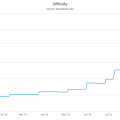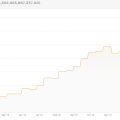Bitcoin mining difficulty continues to increase. At the last recalculation it increased by 6.8% and reached 15,486,913,440293 with a hash rate of 121.6 ech / s.
Tonight the mining difficulty has increasedby almost 7%. The next difficulty level change is expected on March 21st. Despite the coronavirus epidemic, course correction and the approaching halving of the reward, miners continue to increase their capacity. Today's increase in complexity is far from the records of previous years, but against the backdrop of a general decline, it inspires optimism.
Bitcoin mining difficulty level is changingapproximately every two weeks - every 2,016 blocks. As more miners increase the hashrate of the network, the difficulty of PoW increases, making block rewards more difficult to obtain. If miners suddenly stop working en masse, the difficulty will be reduced to maintain balance.
The higher the mining difficulty, the more difficult it isattack the network. According to recent data from analytics company Messari, the cost of a successful 51% attack on the Bitcoin blockchain is more than $21 million per day. For comparison, a similar attack on the Ethereum network costs about $2.7 million.
The current increase in mining difficulty is caused primarily byThe only approaching halving of the reward for the block, which is two months away. Now both new models of miners and old equipment are working, from which they are trying to squeeze the “last juices”, since after the halving in May it (without a rise in the price of BTC) will become unprofitable. After the reward is halved, there is likely to be a sharp drop in difficulty, which will be gradually compensated by the commissioning of new batches of the most energy-efficient ASIC miners.
Let us remember that the last serious fallmining difficulty occurred in November last year. Then the difficulty of mining Bitcoin fell by 7% in one recalculation, and this decrease was the largest in 2019. Previously, a similar drop occurred in December 2018.
</p></p>


